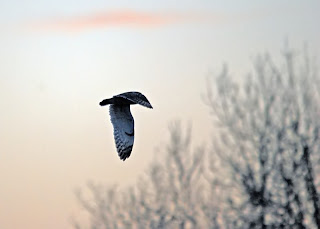Rutland Water in Leicestershire is the largest man made Reservoir in Britain. It is also one of our largest Nature reserves and if you dont own Car, then its virtually impossible to cover its entire circumference! Its location and size acts as a magnate for both migrating and wintering Wildfowl and waders, amongst a multitude of other interesting Birds and Wildlife makes a day and a site of this magnitude is a must to kick-start the year off!We decided to concentrate our efforts around the Egleton Reserve of the site, since it was playing host to two of my bogey birds. Arriving in the carpark we proceeded to tick off some common Birds including a very confiding Blackbird and Fieldfare.
 Common Blackbird (Turdus merula)
Common Blackbird (Turdus merula)
One of the attractions of Rutland Water for Birders is the sites population of Tree Sparrows that can usually be found around the feeders or along the Hedgerows. There is a small hide that overlooks the feeding station and its a great place to see these declining Sparrows at close quarters, aswell as numerous Finches and Titmice.

Eurasian Tree Sparrow (Passer montanus)
European Goldfinch (Carduelis carduelis)
After ticking off a host of common woodland species around the feeders we made our way into the visitor centre for any updated reports on what was about. I managed to dip on the Short-eared Owl that had been hunting over the rough grassland at the back of the lagoon (typical!), and had to make do with dark green coloured megalinic Pheasant, a Kestrel, and a Reed Bunting. Due to the ice, not much else was about.
Common Pheasant (Phasianus colchicus)
We decided to make our way to one of the days target species, namely the 3 Long-eared Owls that were roosting further along the trail. The hides were fairly quiet with very little showing in front of them. We did find some Lesser Redpoll feeding on some Alder catkins, which gave us some excellent close views, if not a little obscured. A female Bullfinch was found along one of the banks, but never stayed long enough to get a decent shot with the camera.

Bullfinch (Pyrrhula pyrrhula)
 Lesser Redpoll (Carduelis cabaret)
Lesser Redpoll (Carduelis cabaret)
Long-eared Owl (Asio otus)
As we made our way towards the hide, we managed to locate another party of Lesser Redpoll in the adjacent Alders. It was nice to see some Wildfowl resting and preening along the waters edge in front of the hide, though they had to move quickly as a couple of Foxes put in an appearance!
 Red Fox (Vulpes vulpes)
Red Fox (Vulpes vulpes) Our visit was beginning to petter out a little due to the frozen conditions. There is however, no better remedy for this than taking a wrong turn and getting tototally lost. It works every time, and wholeheartedly recommend to anyone! You see, if your lost its because you are somewhere where you should not be and the that means yiu are proberly the only person whom has walked down there on that day, which means its vacant of other people and the Wildlife has been undisturbed (brilliant hey!!!!) Basicly, if you avoid being shot by an irate landowner, ran over by a herd of Bullocks, or even arrested...then you should find something!
 Short-eared Owl (Asio flammeus)
Short-eared Owl (Asio flammeus)
Species seen:-
Cormorant, Great Crested Grebe, Grey Heron, Mute Swan, Greylag Goose, Egyptian Goose, Mallard, Teal, Gadwall, Wigeon, Pintail, Shoveler, Tufted Duck, Goldeneye, Goosander, Ruddy Duck, Pheasant, Moorhen, Coot, Buzzard, Kestrel, Merlin, Long-eared Owl, Short-eared Owl, Black-headed Gull, Lesser Black-Back, Herring Gull, Common Gull, Lapwing, Redshank, Curlew, Woodpigeon, Stock Dove, Collared Dove, Feral Pigeon, Robin, Blackbird, Fieldfare, Redwing, Mistle Thrush, Starling, Dunnock, Wren, Pied Wagtail, Skylark, Tree Sparrow, Reed Bunting, Goldfinch, Chaffinch, Bullfinch, Greenfinch, Lesser Redpoll, Carrion Crow, Rook, Magpie, Jackdaw, Blue tit, Great Tit.
Brown Hare, Red Fox, Grey Squirrel



